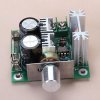First of all, I am just a very very basic electronics guy. I can read circuits and can solder them. I enjoy that immensely. I have built my own chipamp using LM3886 and have done a few other projects too. It is just my hobby. If you ask me why is the transistor there and not here, it will be same as speaking to me in Japanese. 
I am currently building a model lift which were used to carry cargo to replicate the older era manually controlled lift. These were mainly used in deep underground mines. I have a specification about what I want but have no clue has how to implement it. So here I am, seeking help.
There is no control inside the lift. All contols are above on the ground level.
Basically the power supply is a 0-12V DC 7812 regulated DC. The lift motor draws around 800mA of current. I am using a 2A supply that is probably giving around 1.5A. So enough of current there.
Now what I need is a circuit, where I can control this 12 V DC from 0 to 9V. But there are some strings attached and they are the most important.
1. There would be a speed controller of the lift that would vary the voltage from 0 to 9V DC
2. Supposing there is a power cut, the lift should stall slowly.
3. Supposing there is a power resume, the lift should start slowly and take up the speed set may be in 1V/Sec.
4. Suppose someone presses the down button when the lift is going up, the lift should first stall and then go down.
5. An emergency stop function to stop the lift immediately.
The direction of the lift can be controlled by a DPDT type of switch but I am open to ideas. I am not looking for anything complicated just an analog circuit with resistors, capacitors, transistors and ICs.
Any help is appreciated.
Thank you!
Robert.
I am currently building a model lift which were used to carry cargo to replicate the older era manually controlled lift. These were mainly used in deep underground mines. I have a specification about what I want but have no clue has how to implement it. So here I am, seeking help.
There is no control inside the lift. All contols are above on the ground level.
Basically the power supply is a 0-12V DC 7812 regulated DC. The lift motor draws around 800mA of current. I am using a 2A supply that is probably giving around 1.5A. So enough of current there.
Now what I need is a circuit, where I can control this 12 V DC from 0 to 9V. But there are some strings attached and they are the most important.
1. There would be a speed controller of the lift that would vary the voltage from 0 to 9V DC
2. Supposing there is a power cut, the lift should stall slowly.
3. Supposing there is a power resume, the lift should start slowly and take up the speed set may be in 1V/Sec.
4. Suppose someone presses the down button when the lift is going up, the lift should first stall and then go down.
5. An emergency stop function to stop the lift immediately.
The direction of the lift can be controlled by a DPDT type of switch but I am open to ideas. I am not looking for anything complicated just an analog circuit with resistors, capacitors, transistors and ICs.
Any help is appreciated.
Thank you!
Robert.




